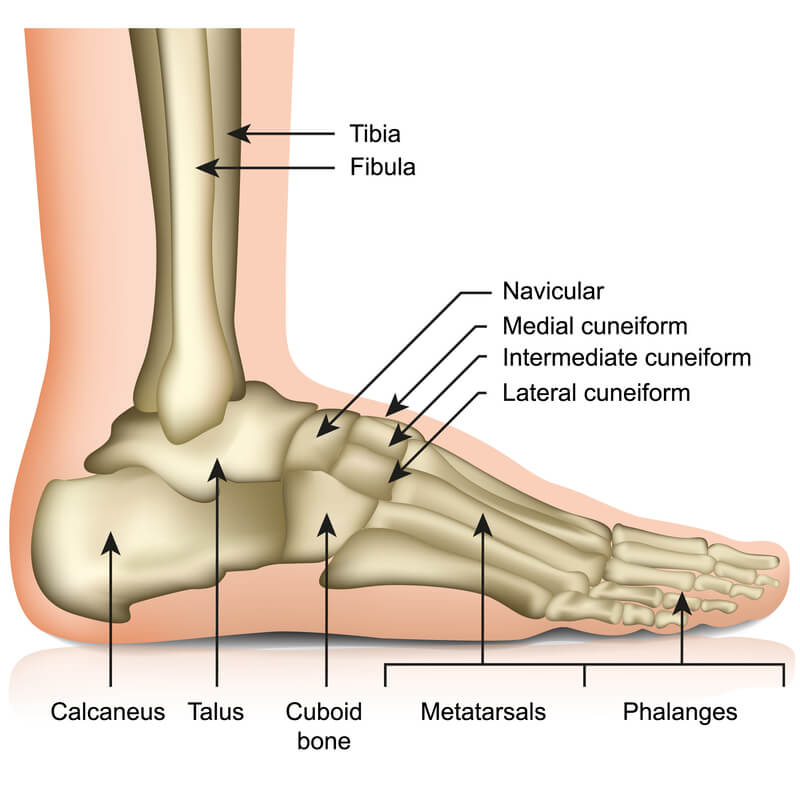
Heel fractures are usually caused by traumatic events, such as automobile accidents or falling from heights (such as a ladder). Other causes of heel fractures can include severe ankle sprains and stress fractures caused by repetitive stress or overuse of the heel bone.
The heel forms a vital part of your weight-bearing ability because your weight ultimately rests on the mechanism of muscle, bone, and tendon that form the heel. The heel also handles the stress of daily activities of walking and running.
Anatomy of the Heel

The heel bone (or calcaneus bone) is a large bone that forms the foundation of the rear part of the foot. The calcaneus connects with the talus and cuboid bones, and the connection between the talus and calcaneus forms the subtalar joint. The subtalar joint is essential for normal foot function.
The calcaneus has a thin, hard shell on the outside and a softer, spongy bone inside. When the outer shell is broken, the bone is likely to collapse and become fragmented. Consequently, heel fractures are severe injuries. When heel fractures involve the joints, there is potential for long-term issues such as arthritis and chronic pain.
Types of Heel Fractures
Heel fractures do not always involve the subtalar and surrounding joints. Fractures affecting the joints (intra-articular fractures) are the most severe calcaneal fractures and can include damage to the cartilage (the connective tissue between two bones). In such cases, healing and recovery depend on the severity of the calcaneus fracture.
Fractures that do not involve surrounding joints (extra-articular fractures) include:
- Those caused by trauma, such as avulsion fractures (in which a piece of bone is pulled off the calcaneus by the Achilles tendon or a ligament) or crush injuries resulting in multiple fracture fragments
- Stress fractures caused by overuse or mild injury
The severity and treatment for such fractures are dependent on their location and size.
Symptoms of Heel Fractures
Heel fractures can have various signs and symptoms, depending on whether they are caused by trauma or stress fractures.
Symptoms of fractures caused by trauma can include:
- Sudden pain in the heel and inability to bear weight on that foot
- Swelling in the heel area
- Bruising of the heel and ankle
Symptoms of stress fractures can include:
- Pain in the general heel area that usually develops slowly (over several days to weeks)
- Swelling in the heel area
Diagnosis of Heel Fractures
During your consultation, Dr. Wawrzynek will ask questions about your injury, and she will examine your foot and ankle. She may also order x-rays or other imaging tests for proper diagnosis.
Treatment for Heel Fractures
Treatment for heel fractures depends on the type and severity of the fracture. Dr. Wawrzynek may recommend conservative treatment options, such as:
- Rest. Stay off the injured foot to allow the fracture to heal.
- Ice. Use ice to reduce swelling and pain. Apply a bag of ice covered with a thin towel to the affected area.
- Compression. Wrap the foot in an elastic bandage or wear a compression stocking to maintain blood flow and reduce discomfort and swelling.
- Elevation. Keep the foot even with or slightly above the heart level to reduce swelling.
- Cast or Cast Boot. Sometimes the foot is placed in a cast or cast boot to keep the fractured bone from moving. Crutches may be needed to avoid weight-bearing.
Treatments for more traumatic heel fractures may require surgery to reconstruct or fuse the joint.
Physical therapy often plays a key role in regaining strength and restoring function once treatment is complete and the fracture has healed.
Dr. Melissa Will Help Get You Back On Your Feet
Dr. Melissa Wawrzynek is a board-certified foot and ankle specialist and offers a broad range of advanced orthopedic, sports medicine, and regenerative treatments.
Our doctor and her team will consult with you regularly to ensure you return to health and receive the highest quality care.
If you’re ready to return to full speed as quickly, easily, and safely as possible, schedule an appointment today.

